A new study by UNC professors raises questions about how we think about drug prosecutions. In Sharks and Minnows in the War on Drugs: A Study of Quantity, Race, and Drug Type in Drug Arrests, the authors reviewed more than 700,000 drug arrests and examined the race of the arrestee, the type of drugs involved, and the quantity of drugs involved. According to the authors, several important points emerge from the data: 1) The vast majority of all drug arrests are for marijuana; 2) The vast majority of all drug arrests are for very small amounts of drugs; 3) People of color are disproportionately arrested for drugs; 4) Such disparities are likely due to the types of drugs targeted by law enforcement and not due to any racial group’s greater involvement in the drug trade. Their study challenges the common rationale for prosecuting low level drug offenders: that in order to catch the big fish (the “sharks”), we must first catch the small fish (the “minnows”). “A drug war premised on hunting great white sharks instead scoops up mostly minnows, and disproportionately ones of color.” Joseph Kennedy, Issac Unah, & Kasi Wahlers, Sharks and Minnows in the War on Drugs: A Study of Quantity, Race, and Drug Type in Drug Arrests, 52 U.C. Davis L. Rev. 729, 730 (2018) (citations hereafter are to the page numbers of the pdf file linked above). The authors argue that their data supports changing the way we approach drug prosecutions by eliminating felony liability in cases involving a gram or less of any drug. This post examines some of those findings.
What make this study different? The study examined drug arrest information from the National Incident Based Reporting System (“NIBRS”) for 2004, 2008, and 2012. It reviewed state and local, not federal, law enforcement agencies and cases in which an arrest was made. While participation among states (and even within a participating state) is far from uniform, 37 states contribute to the NIBRS database (North Carolina does not). The resulting data encompasses around “30% of the U.S. population and 28% of all reported crimes.” Id. at 10. The data included more than a million drug arrests, “making this study the most comprehensive study of drug arrest data undertaken to date by orders of magnitude.” Id.
What was excluded from the study? The analysis excluded cases where there was no measurement of drug quantity, as well as cases with drugs not measurable by weight. As the study notes, the vast majority of drugs are sold by weight. Once these exclusions were applied to the original data set, more than 700,000 cases remained, representing 82% of drug cases within the database with a known measurement during the years examined.
What drugs result in arrest? Marijuana arrests far outnumber all other drug arrests combined, clocking in at 71% of all drug arrests. The authors observed, “[O]ur war on drugs is primarily a war against marijuana.” Id. at 15. Of the remaining drug arrests, nearly half are for cocaine (whether crack or powder), while 6% involved amphetamines and 3% involved heroin (the final 3% was for “other”). The authors include a helpful chart:
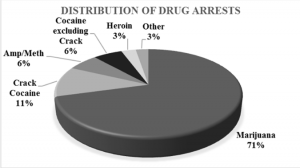
What’s the typical amount involved in a drug arrest? Most arrests for “hard” drugs are for quarter of a gram or less amounts: this quantity supplies 45% of arrests for crack cocaine; 44.1% of heroin arrests; 43.6% of amphetamine arrests; and 37.6% for cases involving powder cocaine. Further, the authors found that arrests for one gram or less of hard drugs “account for somewhere between three-fifths and two-thirds of all hard drug arrests.” Id. at 16. Marijuana is a bulkier substance, typically sold in higher weights, but the amounts are still relatively small: over two-thirds of marijuana arrests are for less than five grams. Id. In chart form, those numbers look like this:
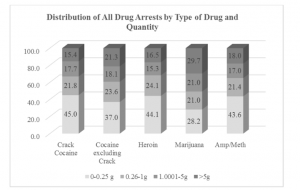
At the other end of the spectrum (not specifically shown in the above chart), drug arrests for hard drugs involving more than a kilogram were less than one percent. Similarly, less than 2% of marijuana arrests are for more than a kilogram. Id. at 17. This, to me, is among the most significant findings of the data. In the words of the study: “We do not seem to be using minnows to catch big fish. Instead, we are catching mainly minnows, occasionally slightly larger fish, and only very rarely a big fish.” Id. at 4. In other words, minnows are not leading to sharks most of the time.
How do drug arrests break down along racial lines? There’s a lot to unpack there, but a couple of points stand out. Relative to the total U.S. population, Whites are arrested for marijuana at a proportional rate and Hispanics at a lower one. In contrast, Blacks are arrested for marijuana at a higher rate—while making up around 13% of the U.S. population, they account for 24% of marijuana arrests.
Whites account for most meth and heroin arrests by far. But these arrests are a small portion of all drug arrests. Blacks account for most arrests for crack cocaine (54.6%) and a large share of powder cocaine arrests (31.7%), a share significantly disproportionate to the total Black population, as the following chart reflects. Id. at 29-30.
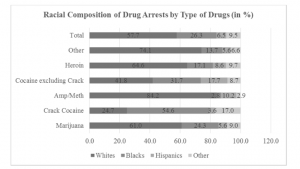
Further, the authors found that crack and powder cocaine arrests make up a much larger share of total drug arrests. While the authors acknowledge that the study does not explain the source of the racial disparity in drug arrests, it cannot be assumed that one group uses a drug more or less than another group. “[W]hites arrested for hard drugs are equally likely to be arrested for crack and powder cocaine. It’s just that we do not arrest very many Whites for either drug, and both drugs constitute the largest chunks of all hard drug arrests.” Id. at 22. This, the authors argue, is likely the result of enforcement primarily aimed at crack and powder cocaine to the exclusion of other drugs.
Simply put, racial disparities in drug arrests would reverse if we arrested as many people for the ‘White drugs’ of heroin and meth/amphetamine as the ‘Black drug’ of crack cocaine—a reasonable thought experiment given the relatively greater potency of a quarter gram of heroin and meth/amphetamine than a quarter gram of crack. As things stand, whatever injustice inheres in the practice of arresting offenders for minuscule amounts of hard drugs falls disproportionately on Blacks. Id. at 31.
Does the punishment fit the crime? Like North Carolina, most states attach felony liability to possession of even trace amounts of hard drugs like cocaine, heroin, and meth. Given that the majority of drug arrests are for small amounts of drugs and that people of color are more likely to be arrested, the authors ask whether it makes sense to impose felony liability with the attendant “life-changing consequences” for those offenders. Possession of a quarter gram or less of marijuana, cocaine, or meth are quantities consistent with personal use and typically range in price between $10 and $50. According to the authors’ research, even those arrested for selling small quantities of drugs are unlikely to be making any significant profit—most likely they are users trying to earn drugs to support their own habit or are people working at the very bottom of a drug organization for low wages (or both). “[T]he drug trade is simply not that profitable for those most likely to be arrested.” Id. at 44. Most drug offenders are small-time “minnows”, and not the high-level “sharks” who make a living from the drug trade (for whom the drug laws were designed).
The social harm involved in drug possession and selling is, in the eyes of the authors, less than the harm involved with many misdemeanors. North Carolina law provides a good comparison—stealing $999 worth of goods, assault on a female or on a government official, assault with a deadly weapon, and sexual battery are all misdemeanors. In light of the standards for those offenses, where there is clear and immediate social harm, the authors ask whether it makes sense to prosecute someone as a felon for having or selling $50 worth of cocaine or other drugs. The authors argue it should not, considering and rejecting various arguments in favor of the existing approach. “Given that gram-or-less amounts are consistent with small scale personal consumption, felony liability for possession or even sale of such an amount cannot be justified in terms of the harms cause by a single transaction or the blameworthiness involved.” Id. at 48.
Impact on North Carolina? As noted at the beginning of the post, North Carolina does not participate in reporting to the NIBRS. While I haven’t been able to find drug quantity data for North Carolina drug arrests, what data we have from the 2018 Sentencing Report, compiled by the North Carolina Sentencing and Policy Commission (“Sentencing Commission”), indicates that nearly a third of all felony convictions involve non-trafficking drug offenses (see chart below). If the national trend identified in the study (that most drug arrests are for a gram or less) applies to North Carolina, a large portion of those convictions may involve a gram or less.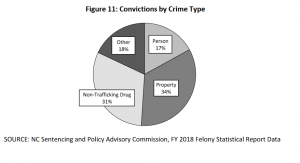
It also appears from the Sentencing Commission’s data that simple possession of hard drugs is used to support habitual felon sentences. More than 10% of habitual convictions were obtained in North Carolina last year where the most serious substantive offense was a felony drug possession offense (although the Sentencing Commission adds the caveat that the most serious felony in a case may not always be the basis for habitualizing the defendant).
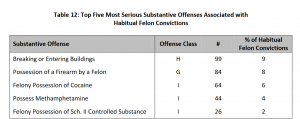
Turning to marijuana, the most common Class 3 misdemeanor conviction in North Carolina is for marijuana (33% of all Class 3 misdemeanor convictions in 2018), an offense involving possession of 1/2 ounce or less. Of all district court misdemeanor convictions, misdemeanor drug offenses make up a substantial portion (27% in 2018).

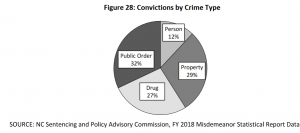
There is a bill pending in the North Carolina General Assembly to decriminalize marijuana possession up to three ounces and to raise the felony amount from 1.5 ounces to 1 pound (16 ounces) (here). If adopted, this approach would undoubtedly reduce arrests, prosecutions, and convictions for the lesser amounts of marijuana. It would also be partially consistent with the recommendation of the authors in their study to “de-felonize” drug possession. The authors would go further, reducing simple possession of all controlled substances to a misdemeanor, a step California took when it changed its criminal code in 2014 (at least for most cases, as summarized here). Whatever approach North Carolina takes, the study’s analysis of the NIBRS data provides a fuller picture of who is getting arrested for drugs and for what amounts. If, as the study suggests, most drug offenders in North Carolina are in fact minnows, is it time to reconsider treating them like sharks? Post a comment and let us know your thoughts.
Reference the large number of arrests for marijuana, I should point out that marijuana is often in “plain view” because it has a distant and strong odor. This leads to more searches of persons and vehicles and more arrests and citations for schedule VI. Imagine if pasta and Axe Body Spray were both illegal, you’d expect to see more arrests for Axe Body Spray (and rightly so).
“While the authors acknowledge that the study does not explain the source of the racial disparity in drug arrests, it cannot be assumed that one group uses a drug more or less than another group.”
Likewise it cannot be assumed that the disproportionate numbers are a result of a deliberate intent to target one racial group over another. In the absence of hard evidence, either hypothesis is possible. Here is another thought experiment: exactly how big does the police conspiracy to target blacks need to be to produce the numbers shown in this study?
“This, the authors argue, is likely the result of enforcement primarily aimed at crack and powder cocaine to the exclusion of other drugs.”
So is there some possible explanation for the focus on crack and powder cocaine versus heroin? Something along the lines of what the commenter Josh above contends? Perhaps crack cocaine is used more frequently in open areas or out in the plain view of officers? Maybe the psychological effects of cocaine versus heroin are such that one can consume more cocaine more frequently, thereby increasing the opportunities to be discovered during an otherwise routine encounter with a police officer.
The bottom line is that this study does not offer us any useful information on which to make any real policy decisions, other than saying, “let’s ‘decriminalize’ more drugs because too many blacks get arrested for them.”
Study after study that I read about have shown that minorities, blacks specifically, are arrested, prosecuted, and receive harsher punishments in comparison to other races when it comes to drug offenses.
The information provided in the above reseach gives us ample information about what can be done to alter policy, investigate further, or conduct more research on the matter.
Legislation can limit the punishment that is given and can alter how drug possession is viewed in our society. There are two categories of crimes: misdemeanors and felonies. What is the issue with creating a new category related to possession? If a state does keep a drug illegal, why not place those particular crimes into a different section to stop the social ramifications you get when pleading to a felony?
Investigating into: how the police conduct searches, why they are going into certain areas more than others, what causes the police to conduct a search, and what policies are in place within a department that focus the cops on certain races are just some areas in which we can hoan in on why this race disparity is occurring.
Research always begets more research topics. The thing we are finding with this research shows drug prosecutions are an issue for minorites. How can we change it?
It can be said that drug ” crimes ” cannot possibly be felonious, that is ” mala in se ” ( bad in and of itself ” because it is a political issue and not a moral one. For example, we all recognize that murder, rape, robbery, arson, assault and every other offense that has defined victims are anti-social in the extreme and that any morally sound person would condemn such actions. However, if someone wishes to use substances for whatever reason may be ” mala prohibita ” ( bad because we say so ” but is not universally condemned and is based on current political influences. Cannabis may be illegal in N.C., but is legal elsewhere. No state will ever legalize a ” mala in se ” offense but politically motivated offenses change as intelligence and logic prevail over lies and self interests. Thus one could argue that no matter how much pot one possessed, it can never rise to a status as ” mala in se ” because no logical person with a sound mind could possibly find that possession of innocuous plant materials was morally outrageous like murder and rape, etc. always is. WE don’t need a separate category for drug offenses, they should all be misdemeanors , with the possible exception of giving drugs to minors or intentionally poisoning someone with a drug. Voluntary use of a drug removes the liability from the provider. Since the government CHOOSES to allow black market distribution of drugs as opposed to regulating and selling it like they do alcohol they can hardly condemn natural market forces for filling the need for supply. Laws on real crimes, violent crimes with real victims will never change radically by location, but created crimes, such as anti-drug laws, change with enlightenment of public officials.
I have a hard time considering this, as well as many other studies along the lines of this one, with much credibility. The main reason is that there are just too many variables in every case throughout the criminal justice system. A study can say that African Americans receive harsher sentences for the same crimes as compared to whites or people of other races. But have they taken into account prior criminal records which in turn affect the sentence that is handed out? Along the same lines, criminal charges are brought about in drug cases in a variety of ways. Was it a call for service and drugs ended up being discovered? Was it a controlled purchase using an informant? Was it due to a probation search in which the probationer tested positive for drugs and a warrantless search then took place? Did an officer simply witness a drug transaction take place and then intervened? The unique circumstances of each and every case means that you will always be comparing apples to oranges to bananas to strawberries to kiwis and so on. These researchers can offer their facts for sale, but I’m not buying it.